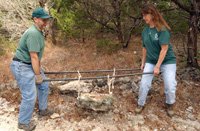Bustamante, Mexico - by Philip Russell
Over president's day weekend, ten trail tamers returned to Bustamante, Mexico. Bustamante, a charming little town older than San Antonio, is just 90 miles south of Laredo. In addition to offering challenging trail work, it has a mountain overlooking the town, springs on the order of Barton Springs, some fine 19th century architecture, pastries, and a distillery producing the local brew known as mescal. Our task was to upgrade a section of mountainside trail leading to a large cave that forms the heart of Bustamante's eco-tourism program. The work is challenging since all the plants are well equipped with thorns, large rocks abound, and soil is a scarce commodity to be sought out and brought back to the site in plastic buckets.

Fortunately, out previous work on the cave trail had weathered last year's hurricane that hit the area. We built on our previous work, filling, hauling, dragging, etc. and left the trail in even better condition for the anticipated rush of visitors over Easter. The Trail Tamer contingent was one of several work projects occurring simultaneously to enhance the cave. All projects were organized by the Texas Speleological Association, which also organized a variety of activities for participants on the second day of our stay.
On the second day, some of us went about 20 miles north to the small town of Candela, where we were greeted by the mayor who took us to a canyon being developed as a park. The tour included a scramble up a hillside to visit a mine that intersected a cave. The mine is no longer worked for its ore, but the bats inhabiting the complex do leave abundant guano which is collected, bagged, and then sold as fertilizer.
A second option involved an extended drive across the desert west of Bustamante. After passing through deserted ranch communities, participants arrived at the Chiquihuitillo Rock Art Site. There, under the shelter of overhanging cliffs, are dozens of Indian rock paintings. Little information is available as to who made the paintings, or when the many geometric shapes were painted.
A third excursion involved a scramble up the canyon at the foot of the mountain where we did the trail work. This excursion provided a good chance to observe desert vegetation and experience hiking along a trail built not for recreation but to carry ore from the mine to the rail line. At the end of the trail was yet another mine-cave complex. (The area is so full of caves that it's hard to open a mine without encountering a cave).
On our last night we had a banquet organized at the funky hotel where we stayed. The following morning we drove back to Austin, after touring the local mescal distillery.



No comments:
Post a Comment